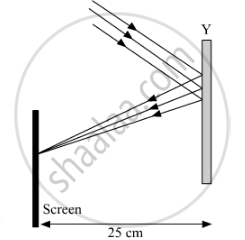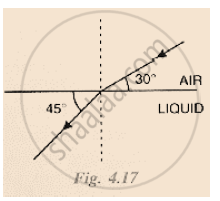Advertisements
Advertisements
प्रश्न
In the following cases, where must an object be placed in front of a convex lens so that the image formed is of the same size as the object?
उत्तर
At 2F.
APPEARS IN
संबंधित प्रश्न
(a) Draw a ray diagram to show the formation of image by a concave lens when an object is placed in front of it.
(b) In the above diagram mark the object distance (u) and the image distance (v) with their proper signs (+ve or –ve as per the new Cartesian sign convention) and state how these distances are related to the focal length (f) of the concave lens in the case.
(c) Find the nature and power of a lens which forms a real and inverted image of magnification –1 at a distance of 40 cm from the optical centre.
Study the given ray diagrams and select the correct statement from the following:


(A) Device X is a concave mirror and device Y is a convex lens, whose focal lengths are 20 cm and 25 cm respectively.
(B) Device X is a convex lens and device Y is a concave mirror, whose focal lengths are 10 cm and 25 cm respectively.
(C) Device X is a concave lens and device Y is a convex mirror, whose focal lengths are 20 cm and 25 cm respectively.
(D) Device X is a convex lens and device Y is a concave mirror, whose focal lengths are 20 cm and 25 cm respectively.
"A lens can form a magnified erect image as well as magnified inverted image of an object placed in front of it." State the nature of this lens and draw ray diagrams to justify the above statement. Mark the positions of O, F and 2F in the diagram.
An object is placed at a distance equal to 2f in front of a convex lens. Draw a labelled ray diagram to show the formation of image. State two characteristics of the image formed.
Describe with the help of a ray-diagram, the size, nature and position of the image formed by a convex lens when an object is placed beyond 2f in front of the lens.
How could you find the focal length of a convex lens rapidly but approximately?
The diagram alongside shows the refraction of a ray of light from sir to a liquid.
(a) write the values of (i) angle of incidence, (ii) angle of refraction.
(b) use snell’s law to find the refractive index of liquid with respect to air.

A convex lens is placed in water. Its focal length will ______.
The focal length of a lens is positive. In this case, state the kind of lens.
A candle is placed between f and 2f a convex lens. Draw a ray diagram showing the position of the image.
